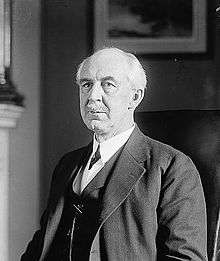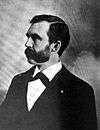Porter H. Dale
| Porter Hinman Dale | |
|---|---|
 | |
| United States Senator from Vermont | |
|
In office November 7, 1923 – October 6, 1933 | |
| Preceded by | William P. Dillingham |
| Succeeded by | Ernest W. Gibson, Sr. |
| Member of the United States House of Representatives from Vermont's 2nd district | |
|
In office March 4, 1915 – August 11, 1923 | |
| Preceded by | Frank Plumley |
| Succeeded by | Ernest W. Gibson |
| Member of the Vermont Senate | |
|
In office 1910–1914 | |
| Personal details | |
| Born |
March 1, 1867 Island Pond, Vermont |
| Died |
October 6, 1933 (aged 66) Westmore, Vermont |
| Political party | Republican |
Porter Hinman Dale (March 1, 1867 – October 6, 1933) was a member of both the United States House of Representatives and later the United States Senate from Vermont.
Early life and career

The son of Lieutenant Governor George N. Dale, Porter Dale was born in Island Pond, Vermont on March 1, 1867.[1]
Dale attended public schools in his hometown and went on to study at Eastman Business College. Later he studied in Philadelphia and Boston, and he spent two years studying elocution and oratory with James Edward Murdoch, a Shakespearean scholar and actor.[2]
Upon completion of his education, he taught school at the Green Mountain Seminary in Waterbury, Vermont, and at Bates College in Lewiston, Maine. Dale then studied law with his father, was admitted to the bar in 1896, and practiced in Island Pond.[3]
Dale served as chief deputy collector of customs at Island Pond from 1897 to 1910, when he resigned and was appointed judge of the Brighton municipal court.[4] He later served in the state militia as colonel on the staff Governor Josiah Grout, and he was also involved in the lumber, electric, and banking businesses.[5]
In 1900 he was an unsuccessful candidate for the Republican nomination in the election for Vermont's Second District seat in the U.S. House.[6] Dale was elected to the Vermont State Senate in 1910 and served two two-year terms.
Congressional career
Dale was the successful Republican nominee in Vermont's Second Congressional District in 1914, and served from March 4, 1915 to August 11, 1923, when he resigned to become a candidate for the United States Senate.[7] Dale served as chairman of the Committee on Expenditures in the Department of the Treasury during the Sixty-Sixth and Sixty-Seventh Congresses.[8]
Dale was campaigning for the Senate on the night of August 2, 1923 when he heard of the death of President Warren G. Harding. Calvin Coolidge was staying at the home of his father John Calvin Coolidge, Sr. in Plymouth, Vermont, and Dale traveled to the Coolidge home to ensure that Coolidge was informed and to offer his assistance. By most accounts, it was Dale who suggested persistently that Coolidge be sworn in immediately to ensure continuity in the presidency, and Dale witnessed Coolidge receiving the oath of office from John Coolidge early on the morning of August 3. Dale later wrote an account of this event.[9][10][11]
Dale was elected to the United States Senate on November 6, 1923 for the remainder of the term ending March 3, 1927, which had been made vacant by the death of William P. Dillingham.[12] Dale was reelected in 1926 and 1932, and served from November 7, 1923, until his death. He was chairman of the Committee on Civil Service (Sixty-ninth through Seventy-second Congresses).
Death and burial
Dale died at his summer home on Lake Willoughby in Westmore, Vermont On October 6, 1933.[13][14][15] He was buried in Lakeside Cemetery in Island Pond.[16]
See also
References
- ↑ Consolidated Publishing, Who's Who in the Nation's Capital, 1921, page 97
- ↑ John J. Duffy, Samuel B. Hand, Ralph H. Orth, editors, The Vermont Encyclopedia, 2003, page 100
- ↑ William Hartley Jeffrey, Successful Vermonters: a modern gazetteer of Caledonia, Essex, and Orleans Counties, Vermont, 1904, pages 12-13
- ↑ James Terry White, The National Cyclopaedia of American Biography, Volume 44, 1967, page 371
- ↑ Dodd, Mead and Company, The New International Year Book, 1934, page 209
- ↑ The Vermonter magazine, Candidates for Congress in the Second District, April, 1900, pages 159-161
- ↑ Vermont State Archives and Records Administration, REPRESENTATIVES TO CONGRESS, Terms of Service, 2008, page 4
- ↑ New York Times, Republicans Name House Committees, April 10, 1921
- ↑ Bill Harris, The First Ladies Fact Book, 2012, page 456
- ↑ Glenn D. Kittler, Hail to the Chief!: The Inauguration Days of our Presidents, 1965, page 167
- ↑ Porter H. Dale, The Calvin Coolidge Inauguration Revisited: An Eyewitness Account by Congressman Porter H. Dale, republished in Vermont History magazine, 1994, Volume 62, pages 214-222
- ↑ New York Times, Vermont to Elect a New U.S. Senator; Porter H. Dale Will Probably Be Chosen to Fill Dillingham's Unexpired Term, November 4, 1923
- ↑ New York Times, Vermont to Fill Senate Vacancy; Seat of Late Porter H. Dale Is Sought by Representative E.W. Gibson, October 22, 1933
- ↑ United Press, Dubuque Telegraph-Herald, Senator Dale, Vermont, Dies, October 8, 1933
- ↑ Boston Globe, U.S. Senator Dale Dead in Vermont, October 7, 1933
- ↑ Esther Buck Hamilton, Vermont is a State I Love, 1976, page 41
External resources
- United States Congress. "Porter H. Dale (id: D000009)". Biographical Directory of the United States Congress.
- Porter Hinman Dale at Find A Grave
| U.S. House of Representatives | ||
|---|---|---|
| Preceded by Frank Plumley |
United States Representative from Vermont (2nd) 1915-1923 |
Succeeded by Ernest Willard Gibson |
| U.S. Senate | ||
| Preceded by William P. Dillingham |
United States Senator (Class 3) from Vermont 1923-1933 |
Succeeded by Ernest Willard Gibson |
![]() This article incorporates public domain material from the Biographical Directory of the United States Congress website http://bioguide.congress.gov.
This article incorporates public domain material from the Biographical Directory of the United States Congress website http://bioguide.congress.gov.
